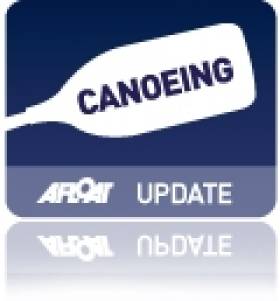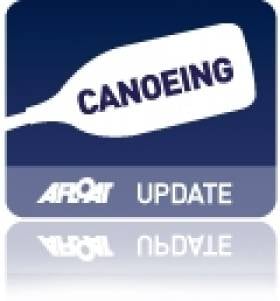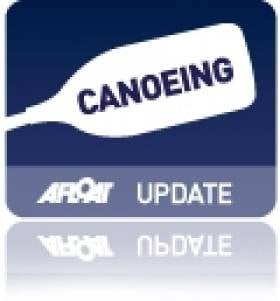Displaying items by tag: Canoe,
#CANOEING: Ciaran Heurteau first represented Ireland in 2006, but he reached new heights today when he finished fifth in the canoe slalom World Cup final in Pau in the Pyrenees.
The 24-year-old, who was brought up in Paris but has an Irish mother, qualified for the final by finishing third in the semi-final, and he competed well. Chasing an exceptional mark of 100.17 seconds set by Etienne Daille of France, Heurteau came down the course in 102.32 seconds, but he had touches on gates 12 and 24 (the second last on the course), which resulted in four seconds in time faults. Daille took gold, while Heurteau was less than a second off a bronze medal.
Canoe Slalom World Cup, Pau, France (Irish interest)
Men,
K1 Semi-Final (First 10 to Final) : 3 C Heurteau 101.74; 22 E Rheinisch 106.90
Final: 1 France (E Daille) 100.17, 2 Czech Republic (J Vondra) 101.46, 3 Australia (L Delfour) 105.40; 5 Ireland (C Heurteau) 106.32.
# CANOEING: Ciaran Heurteau gave an outstanding performance for the second day in succession to reach the final of the Canoe Slalom World Cup in Pau in France. Heurteau had finished 13th in the heats to make the semi-finals, but he bettered that this morning, finishing third in 101.74 seconds. Eoin Rheinisch also touched no gates in his round, but his time of 106.90 placed him in 22nd, with just 10 going through to the final.
Canoe Slalom World Cup, Pau, France (Irish interest)
Men, K1 Semi-Final (First 10 to Final) : 3 C Heurteau 101.74; 22 E Rheinisch 106.90
Two Irish Canoeists Progress at World Cup in France
# CANOEING: Ireland’s Ciaran Heurteau (13th) and Eoin Rheinisch (32nd) qualified for the semi-finals of the Canoe Slalom World Cup in Pau in France today. Heurteau qualified with a very good first run, while Rheinisch had to wait until his second run to qualify.
Canoe Slalom World Cup, Pau, France (Irish interest)
Men's K1 Heats (40 qualify for Semi-Final): 13 C Heurteau 91.83 (1st run); 32 E Rheinisch 93.63 (2nd run).
Watkins Impresses at Canoe Sprint World Cup
# CANOEING: Barry Watkins had an excellent first day at the Canoe Sprint World Cup in Duisburg in Germany. He qualified for the A Final of the K1 500 metres, winning his heat and placing third in the semi-final. He also reached the B Final in the K1 1,000 metres. Jenny Egan made it to the semi-finals of the K1 500 metres.
Canoe Sprint World Cup Two, Dusiburg (Selected Results; Irish interest)
Men
K1 1,000 Semi-Final: 5 B Watkins 3:39.586
K1 500 – Heats Three: 1 Watkins 1:45.552. Semi-Final Three – 3 Watkins 1:42.705
Women
K1 500 Semi-Final: 8 J Egan 2:06.936
Jezierski Qualifies Ireland Boat for Olympic Games
# CANOEING; Ireland booked a place for a third canoeist at the Olympic Games as Andrzej Jezierski fought through difficult conditions to take second place in the Olympic Qualifier in Poznan in Poland today. The Polish man who lives and works in Cork came in just over half a second behind Hagara Lubomir of Slovakia.
Jenny Egan failed to make the final in the K1 200 metres, but there are still hopes that she will make it through in the K1 500m in which she finished seventh earlier in the day.
European Canoe Sprint Olympic Qualifier – Day Two (Irish interest)
Men – C1 200m – A Final (First Two Qualify): 1 Slovakia (L Hagara) 42.518, 2 Ireland (A Jezierski) 43.034; 3 Czech Republic (M Fuksa) 43.522, 4 Germany (S Kiraj) 43.746, 5 Romania 44.186, 6 Latvia 45.202, 7 France 45.366, 6 Georgia 45.594, 9 Hungary disqualified.
Women, K1 500m – A Final: 1 Russia (Y Kachalova) 2:00.037, 2 Norway (MV Larsen) 2:01.281, 3 Poland (K Naja) 2:01.769, 4 Austria (AR Lehaci) 2:02.801, 5 Romania (R Borha) 2:03.317, 6 Spain (A Portela) 2:03.701, 7 Ireland (J Egan) 2:04.061, 8 Sweden (A Roger) 2:05.377, 9 Netherlands (E Haaze) 2:06.489.
K1 200 – Semi-Final: 1 Italy 45.253; 6 Egan 48.641.
Egan Seventh In Olympic Qualifier A Final
#CANOEING: Jenny Egan missed out on the automatic Olympic qualification places in the women’s K1 500 metres at the European Canoe Sprint qualification event in Poznan in Poland today. The Kildare woman finished seventh in the A Final, but only the top two are certain of places in London. Some more places may become available later in the summer. Egan goes in the K1 200 semi-final later today.
European Canoe Sprint Olympic Qualifier – Day Two (Irish interest)
Women, K1 500m – A Final (two automatic places for Lodnon 2012): 1 Russia (Y Kachalova) 2:00.037, 2 Norway (MV Larsen) 2:01.281; 3 Poland (K Naja) 2:01.769, 4 Austria (AR Lehaci) 2:02.801, 5 Romania (R Borha) 2:03.317, 6 Spain (A Portela) 2:03.701, 7 Ireland (J Egan) 2:04.061, 8 Sweden (A Roger) 2:05.377, 9 Netherlands (E Haaze) 2:06.489.
#CANOEING: Two Ireland boats have qualified for tomorrow’s finals at the European Olympic Qualifier for canoe sprint in Poznan in Poland. Andrzej Jezierski won his heat of the C1 200, while Jenny Egan came through a semi-final to make the final of the K1 500 metres. She also has a chance of making the K1 200 metres final, as she has qualified for the semi-final.
Jezierski is a former world champion with his native Poland who now lives and works in Co Cork. He has been training at the National Rowing Centre at Farran Wood and recently declared for Ireland.
European Canoe Sprint Olympic Qualifier, Poznan, Poland (Irish interest)
Men
C1 200 – Heat One (First Three to Final): 1 Ireland (A Jezierski) 43.451, 2 France (T Simart) 43.739, 3 Romania (J Chirila) 44.739.
K1 200m – Heat One (First to A Final; 2-7 to semi-finals): 8 Ireland (S Marchetti) 43.825.
K1 1,000m – Heat Three (1st to Final; rest to Semi-Final): 5 N Fleming 3:48.069. Semi-Final (1-3 to A Final): 5 Fleming 3:45.819
K2 200m – Heat One (1-3 to Final; 4-7 plus one best time to Semi-Final): 8 S Marchetti/V Peirce 36:549. Semi-Final (1-3 to Final): 8 Marchetti/Peirce 35.645.
Women
K1 500 – Heat Two (1-3 to Final; 4-7 plus one best time to Semi-Final): 5 J Egan 2:02.124. Semi-Final (1-3 to A Final): 1 Norway (MV Larsen) 2:01.083, 2 Spain (M A Portela) 2:01.363, 3 Egan 2:02.215
K1 200 – Heat Two (1-3 to Final; 4-7 plus next best time to Semi-Final): 5 Egan 46.264.
Rheinisch Qualifies for Olympic Games in Canoe Slalom
#CANOEING: Eoin Rheinisch qualified for the Olympic Games with a fault-free round in the K1 (racing kayak) at the European Championships in Augsburg in Germany today. The Kildare man, who finished 4th at the Beijing Olympics, took 12th place with a run of 98.38 seconds in the semi-final. It gave him the first of two places available to boats from countries not already qualified; Croatia’s Dinko Mulic took the second by finishing 17th. Ireland’s Ciaran Heurteau finished 20th.
European Canoe Slalom Championships, Augsburg, Germany
Men – K1 (racing kayak) Semi-Final (first two countries not already qualified for Olympic Games qualify)
1 Germany (H Aigner) 93.99; 12 Ireland (E Rheinisch) 98.38; 17 Croatia (D Mulic) 100.42; 20 Ireland (C Heurteau) 100.20; 21 Slovakia (J Sajdibor) 100.27.
Craig Books Her Place in Canoe Slalom at London 2012
#CANOEING: Hannah Craig is set to represent Ireland at the Olympic Games in London in the K1 racing kayak. The Antrim woman finished 25th at the European Canoe Slalom Championships in Augsburg today, the highest position occupied by a boat from a country not already qualified. Elise Chabbey of Switzerland took the second place on offer by finishing 32nd.
Canoe Slalom European Championships, Augsburg, Day Two
Women
K1 (racing kayak) Heats (1st and 2nd runs): 1 Germany (J Schornberg) 99.26 seconds (2nd run); 25 Ireland (H Craig) 105.69 (2nd run); 32 Switzerland (E Chabbey) 109.32 (2nd run) 47 Ireland (H Barnes) 112.14 (1st run); 40 Ireland (A Conlon) 120.18 (1st run).
#CANOEING: Ireland’s Eoin Rheinisch and Ciaran Heurteau will be in the hunt for an Olympic place in tomorrow’s semi-finals of the K1 canoe slalom at the European Championships in Augsburg in Germany. Rheinisch finished 17th and Heurteau 23rd in the heats on Thursday. The top two boats from countries which have not already qualified will book their places for London. Croatia (8th) and Slovakia (12th) had boats ahead of Ireland in the heats. The heat times will not count in tomorrow’s semis.
Rheinisch and Heurteau combined with Patrick Hynes to place Ireland 10th in the semi-final of the team event.
Ireland’s three women competitors go into action today.
European Canoe Slalom Championships, Augsburg, Germany
Day One (Selected Results)
Men, K1 Heats (1st and 2nd runs): 1 Germany (P Boecklemann) 88.10 (first run); 8 Croatia (D Mulic) 91.4 (second run); 12 Slovakia (M Halcin) 92.09 (second run); 17 Ireland (E Rheinisch) 92.93 (second run); 23 Ireland (C Heurteau) 93.78 (first run); 60 Ireland (P Hynes) 106.99 (first run).
K1 Team – Semi-Final: 1 France 100.19; 10 Ireland (E Rheinisch, C Heurteau, P Hynes) 108.2.






































































